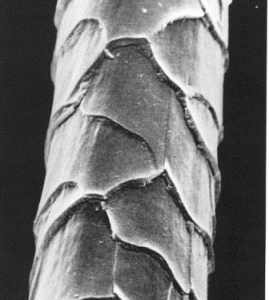Hey guys, just thought I would post a quick video showing where the wool comes from to make alpaca socks. This alpaca wool can be used for making yarn and many other finished goods that you can now buy. Enjoy
Hey guys, just thought I would post a quick video showing where the wool comes from to make alpaca socks. This alpaca wool can be used for making yarn and many other finished goods that you can now buy. Enjoy
For years wool has been used to manufacture garments of all kinds. From socks to blazers, wool has been the textile of choice for many individuals. Its warmth and durability has made it a favorite for consumers all over the world. The main issue for some has been the obvious issues with wool such as its itchiness due to the structural makeup of the wool fiber. In the picture below you can  see a wool fiber at the microscopic level.
see a wool fiber at the microscopic level.
In the picture it is easy to see each individual scale on the wool fiber. Wool has large scales that, at a microscopic level, are raised fairly high causing them to “catch” on your skin thus causing that itch. These individual raised scales cause the individual wool fibers to lock into one another, a definite benefit however, they also catch dirt and grit and can cause the wool to break down sooner if not taken care of. This also make wool a bad choice for next-to-skin wear.
Click here now to get non-chemically treated Alpaca Socks!
When compared to alpaca fiber you can see that the scales of the alpaca fiber are much smaller than those of many commonly used fibers.
The scales on the alpaca fiber are much smaller and do not rise up as high. This smaller scale greatly reduces the itch factor and makes for a stronger fiber. Wearing quality alpaca next to your skin should not cause any irritation due to itching. Many people have even compared alpaca fleece to cashmere. When you look at the picture above you may see why.
To combat some of these negative features of wool some clothing lines are now being promoted as “superwashed” for next-to-skin capabilities by removing the wool’s lanolin and barbs. According to Textile Chemicals: Environmental Data and Facts, the superwashed wool is treated with synthetic resins (polyamide / epichlorohydrine or polyurethane), a method that can include such chemicals as chlorine and hypochlorous acid, sulphuric acid, sodium hypochlorite, alkali metal salts of dichloroisocyanuric acid (DCCA) and an acid-stable wetting agent. The chlorination process for wool has lead to enormous environmental problems. Alpaca now offers an eco-friendly alternative to natural fiber active wear
When I read about the chemicals used in the new wool products that have gained some popularity in the market place I was shocked. I could not imagine placing these new products that have been infused with these harsh chemicals on my body, even if they were only socks.
The good news is alpaca fiber does not have to be treated with any harsh chemicals so that you can wear it next to your skin. This along with the many other beneficial characteristics of alpaca that has been described in my other posts make alpaca a top choice for a natural fiber that is strong, soft and definitely easy on the environment.
I don’t know about you, but when I am looking for something to keep my feet warm having chemically treated materials next to my skin just does not make me feel comfortable. Knowing that alpaca socks do not have to be treated to make them feel soft or to remove any allergen gives me piece of mind that me and my family can where a product that is not potentially dangerous to our health. This once again proves to me that Alpaca Socks, or any garment made from Alpaca, is the best choice.
Knowing that alpaca socks do not have to be treated to make them feel soft or to remove any allergen gives me piece of mind that me and my family can where a product that is not potentially dangerous to our health. This once again proves to me that Alpaca Socks, or any garment made from Alpaca, is the best choice.
Click here now to get non-chemically treated Alpaca Socks!
-Jonothan
When choosing a pair of socks to keep your feet warm you should look for two very important things.
The first is the actual textile being used to manufacture the socks. Is it synthetic, wool, cashmere, cotton or alpaca? Alpaca fleece that is used in making alpaca socks is naturally moisture wicking, warmer than sheep’s wool, softer than sheep’s wool and is lanolin free thus making it virtually Hypo-allergenic. Sheep’s wool for years been the choice for warmth and the price and availability has definitely enabled its rise. The downside though has been the “itch factor”, the lack of moisture wicking and that it contains lanolin. Lanolin is natural oil secreted onto the fiber from the sheep as the wool grows. There are a lot of people that are allergic to lanolin and cannot where wool do to this allergy. Cashmere is really comfortable however price and availability are issues. Cotton, most widely used fiber, is not very warm to start with. And when wet, the cotton fibers actaully break down causing it to lose it’s cushioning ability. It also lacks the moisture wicking ability that is actually needed for truly warm socks.
Click here to get the warmest socks you may ever own!
The Second is keeping your feet dry. Alpaca socks are very adept at this because the wool, (fleece) used to manufacture these socks have hollow cores allowing it to wick the moisture away from your feet. This is a natural property of alpaca fleece and is a huge benefit and does not need to be engineered into the product. The action of moving moisture away from your skin increases the feel of Regular sheep’s wool does not have this property and tends to hold moisture close to your feet keeping your feet moist and allows for bacteria to grow, causing “stinky feet”. Alpaca fleece, along with this natural wicking ability, also has natural anti-microbial properties even further reducing the smelly feet syndrome. This has been a joyous side effect for me once I purchased a few pairs for my teenage boys!
For me the choice is clear. Alpaca wool (fleece) is gaining popularity and is the choice for me in choosing a pair of warm socks. After owning multiple pairs of these all terrain survival socks I am a true believer in the benefits that alpaca has and hopefully you will to.
Click here for immediate shipping of wonderful alpaca socks!
–